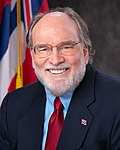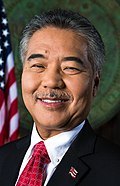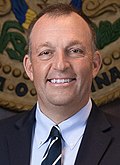| Governor of Hawaii | |
|---|---|
| Ke Kiaʻaina o Hawaiʻi | |
 Gubernatorial standard | |
| Residence | Washington Place |
| Term length | Four years, renewable once |
| Precursor | Governor of Hawaii Territory |
| Inaugural holder | William F. Quinn |
| Formation | August 21, 1959 |
| Succession | Line of succession |
| Deputy | Lieutenant Governor of Hawaii |
| Website | governor |


The governor of the State of Hawaii is the head of government of Hawaii, [1] and commander-in-chief of the state's military forces. [2] The governor has a duty to enforce state laws; [2] the power to either approve or veto bills passed by the Hawaii Legislature; [3] the power to convene the legislature; [4] and the power to grant pardons, except in cases of treason and impeachment. [2]
Contents
- List of governors
- Hawaii Territory
- State of Hawaii
- Electoral history
- See also
- Notes
- References
- External links
Of the eight governors of the state, two have been elected to three terms, four have been elected to two terms, and one has been elected to one term. No state governor has yet resigned or died in office, nor did any territorial governor die in office. George Ariyoshi was the first Asian American to be governor of any U.S. state. The current governor is Democrat Josh Green, who took office on December 5, 2022.
The longest-serving governors are John A. Burns (1962–1974) and George Ariyoshi (1974–1986), both of whom served 12 years each.





















